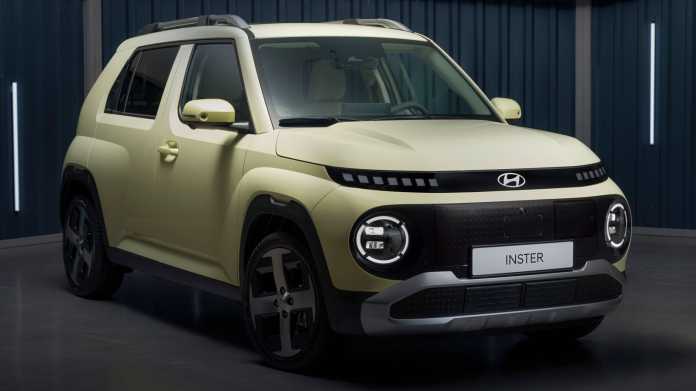Hyundai Inster electric car: the big in a small package
Hyundai Inster: As small as a Dacia Spring, but holds up to 49 kWh. Shorter than a Citroën ë-C3, but with the functions and variability of more expensive cars.

(Image: Hyundai)
- Christoph M. Schwarzer
Hyundai has presented the electric subcompact Inster. At 3.83 meters long and 1.61 meters wide, it competes in size with the Dacia Spring (3.70 meters and 1.58 meters). Both have an SUV-like design. But that's it for the similarities: The Hyundai Inster is a contemporary electric car that has quite a few functions and features that are actually reserved for higher vehicle classes. It also offers unique variability: the driver and front passenger seats can be folded down. This creates an area that is suitable for sleeping, for example. The Hyundai Inster will therefore become a micro-camper in some cases. However, most buyers will probably use this subcompact car more typically for shopping and commuting. The price is said to be "under 25,000 euros" - whatever that means.
Hyundai Inster (5 Bilder)

There is no date for the sales launch yet. One of the reasons Hyundai needs the Inster is because the company will miss the CO₂ targets for 2025 according to the latest surveys. However, German and other customers in Europe can also make good use of the Inster. After all, Hyundai currently charges at least 34,990 euros for an electric car. For this, the customer gets a Kona electric with basic equipment, considering a current promotional price. That is far too much for the majority of potential buyers. The car industry is currently tentatively starting to sell viable electric cars in the A and B segments. The best-known example: the Citroën ë-C3 for 23,300 euros.
DC-capable as standard, various battery sizes
At 4.02 meters long and 1.76 meters wide, the ë-C3 is slightly larger than the Hyundai Inster. Nevertheless, a comparison is worthwhile: unlike the Dacia Spring or the Renault R5, both are DC-chargeable as standard and need around half an hour to charge from ten to 80 percent. The Hyundai Inster always has a three-phase AC charger with 11 kW output; the Citroën costs 400 euros extra.
The energy content of the traction battery in the Hyundai Inster is either 42 or 49 kWh. The driving performance of the two versions: With 71.1 and 84.5 kW from the electric motor, it goes to 100 km/h in 11.7 and 10.6 seconds respectively. The top speeds are 140 and 150 km/h respectively. The Inster has not yet been homologated; Hyundai states a range target of over 350 km for the larger traction battery. With 42 kWh it should be around 300 km. The provisional standard consumption for both is 15.3 kWh per 100 km.
Read also
Base or Cross?
The fact that there are two traction batteries with such a small difference in energy content suggests that different cell chemistries are used. It is speculation, but it is possible that the 42 kWh version has low-cost LFP cells and the 49 kWh version has NMC cells. As a result, the difference in price could be higher than the capacity figures suggest.
Two equipment variants are planned: Base and Cross. The latter has roof rails and different bumpers, and is therefore 3.5 cm higher and 2 cm longer than the Base. Hyundai does not always clearly communicate which functions are standard and which cost extra. It is clear that LED headlights are not available in every Inster. There are steel rims with a diameter of 15 inches and aluminum rims with 15 or 17 inches.
V2L, ACC, 360-degree camera
For camping enthusiasts - see above - the Hyundai Inster has a socket with 220 volt voltage and 16 ampere current (Vehicle to Load or V2L) both inside and outside. Hyundai does not specify whether these functions are included as standard. It is also unclear whether all Inster models will have battery heating and a heat pump.
These two features are not mentioned anywhere in the Citroën ë-C3. This also applies to the extensive assistance systems in the Hyundai Inster. In excerpts: From adaptive cruise control to a 360-degree camera, there is a lot available that is unusual in this class. This sets the Inster apart from its direct competitors.
Five-seater with sliding rear seats
Hyundai will offer a four-seater and a five-seater version of the Inster. The rear seat bench can be divided and folded down. The five-seater also has sliding individual seats with adjustable backrests. This results in a trunk volume of 280 to 351 liters, which can be extended to up to 1059 liters. A wheelbase of 2.58 meters is large for the A-segment. Apparently Hyundai has not simply converted the Casper from South Korea from combustion to electric mode, but has extended it by 23 cm. This is to create space for people and the battery.
Hyundai Inster (6 Bilder)

Competitors will take a close look at what the Inster offers and what Hyundai charges for the respective features. Particularly in terms of variability, small and micro cars have the opportunity to set themselves apart: Renault, for example, will recall the original Twingo and its sleeping function for the electric Twingo (2026). With the VW ID.2, Volkswagen wants to offer a huge trunk with 440 to 1330 liters and has not yet shown an electric car with V2L. Other seedlings from the Group are in preparation. However, the decisive factor in this market segment is the price. When Hyundai talks about less than 25,000 euros, this can also mean less than 20,000 euros. But it can also mean that there is a meager basic model for 24,990 euros.
More about Hyundai
US electric cars: Tesla threatens to lose its absolute majority
(emw)